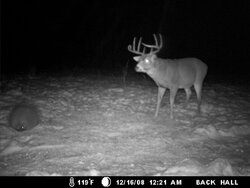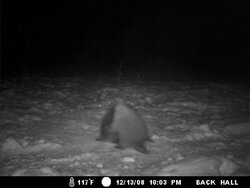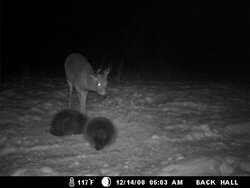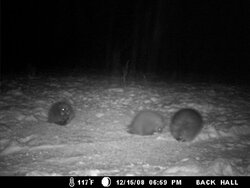Hey!
I seem to be having a problem with porcupines. They are chewing on oaks in many places in my woods. The buggers seem to prefer thriving, young oaks though I see that they also chew on lindens, and chokecherry trees.
When I first moved out into the woods, I noticed that a lot of oaks had two-stage bark--- they had normal, heavy bark higher up the tree but younger, thinner bark at their bases. I puzzled over this for years until I saw fresh chewings and came to the understanding that it was being done by porcupines.
I spotted one up in an oak last week and shot it. My policy towards wildlife is to leave it alone unless it is causing me a problem. But if it is causing me a problem, I kill. I took a sled out and brought it back up to the yard. They're not on my bill of fare--- at least not yet, so I called a buddy who does eat such things and he came out and picked it up.
But now, as spring is beginning to come here up north, I am getting out into the woods more often and am seeing more porcupine damage in many other spots. I am tempted to engage in an all-out war, but then I think about the old oaks that seem to have survived such damage in the past. I don't like the idea of denying habitat to one of God's creatures, but I worship my big, old oaks and I figure that these creatures could do their thing elsewhere. We had them out on the prairies where I grew up. However, if the damage they are inflicting is not serious then I think I might like to leave them alone. But if the damage is actually killing some of the young oaks, I may choose to provide Old Dave with more roasts.
Anyone have any observations?
I seem to be having a problem with porcupines. They are chewing on oaks in many places in my woods. The buggers seem to prefer thriving, young oaks though I see that they also chew on lindens, and chokecherry trees.
When I first moved out into the woods, I noticed that a lot of oaks had two-stage bark--- they had normal, heavy bark higher up the tree but younger, thinner bark at their bases. I puzzled over this for years until I saw fresh chewings and came to the understanding that it was being done by porcupines.
I spotted one up in an oak last week and shot it. My policy towards wildlife is to leave it alone unless it is causing me a problem. But if it is causing me a problem, I kill. I took a sled out and brought it back up to the yard. They're not on my bill of fare--- at least not yet, so I called a buddy who does eat such things and he came out and picked it up.
But now, as spring is beginning to come here up north, I am getting out into the woods more often and am seeing more porcupine damage in many other spots. I am tempted to engage in an all-out war, but then I think about the old oaks that seem to have survived such damage in the past. I don't like the idea of denying habitat to one of God's creatures, but I worship my big, old oaks and I figure that these creatures could do their thing elsewhere. We had them out on the prairies where I grew up. However, if the damage they are inflicting is not serious then I think I might like to leave them alone. But if the damage is actually killing some of the young oaks, I may choose to provide Old Dave with more roasts.
Anyone have any observations?






